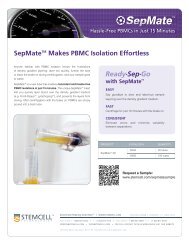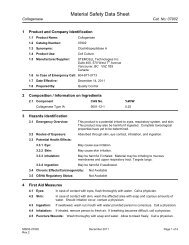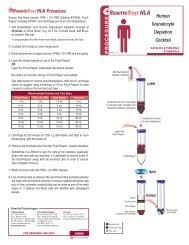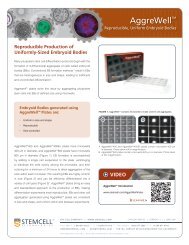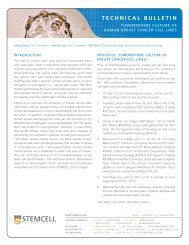HetaSep™ Tissue Culture Reagents
HetaSep™ Tissue Culture Reagents
HetaSep™ Tissue Culture Reagents
You also want an ePaper? Increase the reach of your titles
YUMPU automatically turns print PDFs into web optimized ePapers that Google loves.
PRODUCT DESCRIPTION<br />
Recommended for isolation of human nucleated cells from<br />
peripheral blood.<br />
HetaSep contains:<br />
Hetastarch (6% w/v)<br />
Sodium Chloride<br />
Sodium Lactate (Anhydrous)<br />
Dextrose (Hydrous)<br />
Calcium Chloride Dihydrate<br />
Potassium Chloride<br />
Magnesium Chloride Hexahydrate<br />
HetaSep is aseptically manufactured using tightly controlled<br />
processes.<br />
Each<br />
batch of HetaSep is sterility tested. A Certificate of<br />
Analysis is available upon request.<br />
STABILITY AND STORAGE<br />
Product stable at room temperature (15 - 25°C) until expiry date<br />
indicated on label.<br />
Storage at 2 - 8°C is acceptable, but ensure that the solution<br />
equilibrates to room temperature (15 - 25°C) and invert bottle to<br />
mix contents before use.<br />
Protect from direct light.<br />
DIRECTIONS FOR USE<br />
Leukocyte-rich plasma can be prepared from peripheral blood<br />
samples by sedimentation of red blood cells through HetaSep<br />
using either the gravity sedimentation or the centrifugation method<br />
outlined below.<br />
NOTE: If using HetaSep in conjunction with an EasySep ®<br />
negative selection kit, please use the HetaSep procedure<br />
recommended on the EasySep ® PIS.<br />
Gravity Sedimentation<br />
Gravity sedimentation is a simple and reliable method of red blood<br />
cell (RBC) depletion. A defined interface forms between the RBC<br />
fraction and the RBC-depleted (nucleated cell-rich) fraction as the<br />
RBC sediment through the HetaSep solution. Approximately<br />
99% RBC depletion is attained if the nucleated cell-rich fraction is<br />
removed carefully.<br />
1. Select an appropriately sized tube.<br />
2. Add 1 part HetaSep solution to 5 parts blood. Mix well. If<br />
using a blood bag, add HetaSep directly to the bag and mix.<br />
3. Allow sample to settle until the plasma:RBC interface is at<br />
approximately 50% of the total volume. Placing the tube in a<br />
37°C incubator for this step will increase the sedimentation<br />
rate.<br />
4. Harvest the leukocyte-rich plasma layer and place in a 50 mL<br />
tube. Wash this fraction once with at least a four-fold volume of<br />
appropriate medium. This may require several tubes. Perform<br />
a slow spin to remove platelets by centrifuging at 120 x g for<br />
10 minutes at room temperature (15 - 25°C) with no brake.<br />
5. If excessive platelet contamination is expected, repeat this<br />
wash step.<br />
<strong>Tissue</strong> <strong>Culture</strong><br />
<strong>Reagents</strong><br />
VERSION 3.0.0<br />
WWW.STEMCELL.COM FOR RESEARCH USE ONLY. NOT FOR THERAPEUTIC OR DIAGNOSTIC USE.<br />
HetaSep<br />
CATALOG #07806 20 mL<br />
CATALOG #07906 100 mL<br />
6. Remove supernatant carefully and resuspend the cells in a<br />
small volume (typically the nucleated cells from 10 mL of blood<br />
would be finally resuspended in 0.5 - 1.0 mL of medium).<br />
7. Optional: Any residual RBCs may be lysed with ammonium<br />
chloride (Catalog #07800/07850), if desired.<br />
Centrifugation<br />
Centrifugation may be used to accelerate the sedimentation<br />
process.<br />
1. Based on blood sample volume, select an appropriately sized<br />
tube according to Table 1.<br />
2. Add 1 part HetaSep to 5 parts whole blood. Mix well.<br />
3. Centrifuge sample at room temperature (15 - 25°C) at 90 x g<br />
with the brake off according to Table 2.<br />
4. Remove sample from centrifuge and allow to sit undisturbed<br />
at room temperature for ten minutes. This will allow further<br />
sedimentation of the RBC and will improve recovery of the<br />
nucleated cells.<br />
5. Harvest the leukocyte-rich supernatant into a fresh 50 mL<br />
tube. Up to 5 - 10% of the initial red blood cells may not have<br />
sedimented and thus may still remain in this fraction. This is<br />
expected.<br />
6. Wash this fraction once with at least a four-fold volume of<br />
appropriate medium. This may require several tubes. Perform<br />
a slow spin to remove platelets by centrifuging at 120 x g for<br />
10 minutes at room temperature (15 - 25°C) with no brake.<br />
7. If excessive platelet contamination is expected, repeat this<br />
wash step.<br />
8. Remove supernatant carefully and resuspend the cells in a<br />
small volume (typically the nucleated cells from 10 mL of<br />
blood would be finally resuspended in 0.5 - 1 mL of medium).<br />
9. Optional: Any residual RBCs may be lysed with ammonium<br />
chloride (Catalog #07800/07850), if desired.<br />
NOTE: The age of the blood sample impacts how fast and to what<br />
extent the RBCs sediment. Accordingly, the interface between the<br />
plasma fraction and the RBC fraction may be less distinct in older<br />
samples. Haemolysis also makes visualization of the interface less<br />
obvious.<br />
MAY 2009<br />
#29622
07806_07906 Page 2<br />
Table 1. Tube size recommendations for centrifugation<br />
WHOLE BLOOD<br />
VOLUME<br />
1 - 4 mL<br />
5 - 10 mL<br />
RECOMMENDED TUBE SIZE<br />
Falcon 5 mL polystyrene round-bottom<br />
tubes<br />
(Becton-Dickinson, Catalog #352058)<br />
Falcon 14 mL round-bottom tubes<br />
(e.g. Becton-Dickinson, Catalog #352057)<br />
OR 15 mL conical tubes<br />
(e.g. Corning, Catalog #430053)<br />
Table 2. Centrifuge times based on sample age<br />
SPIN TIME (MIN)<br />
START<br />
VOLUME*<br />
TUBE<br />
SIZE FRESH<br />
BLOOD<br />
24 HR<br />
OLD<br />
BLOOD<br />
48 HR<br />
OLD<br />
BLOOD<br />
2 mL 5 mL 1 1 2<br />
3 mL 5 mL 1 1 4<br />
4 mL 5 mL 2 2 5<br />
10 mL 14 mL 5 5 7<br />
*Start volume refers to volume of blood before HetaSep addition.<br />
NOTE: Contact Technical Support for centrifuge speeds and times<br />
if processing blood in a 50 mL tube.<br />
SEPARATION PRINCIPLE<br />
Red cell aggregating agents such as HetaSep increase the RBC<br />
sedimentation rate by increasing the effective size of the cells<br />
through formation of aggregates, or rouleaux. Because nucleated<br />
cells settle at a lower rate, a compact pellet consisting mainly of<br />
RBC is formed rapidly in the presence of HetaSep, while the<br />
nucleated cells remain suspended in the supernatant.<br />
REFERENCES<br />
1. Regidor C, Posada M, Monteagudo D, Garaulet C, Somolinos N,<br />
Fores R, Briz M, Fernandez MN: Umbilical cord blood banking for<br />
unrelated transplantation: evaluation of cell separation and storage<br />
methods. Exp Hematol 27: 380-385, 1999<br />
2. Rubinstein P, Dobrila L, Rosenfield RE, Adamson JW, Migliaccio G,<br />
Migliaccio AR, Taylor PE, Stevens CE: Processing and<br />
cryopreservation of placental/umbilical cord blood for unrelated bone<br />
marrow reconstitution. Proc Natl Acad Sci USA 92: 10119-10122,<br />
1995<br />
Add 1 part<br />
HetaSep to 5<br />
parts whole blood<br />
Spin or Gravity Sedimentation<br />
Collect<br />
supernatant above<br />
the RBC fraction<br />
Wash<br />
Cells are now ready for use or<br />
downstream assay<br />
WWW.STEMCELL.COM FOR RESEARCH USE ONLY. NOT FOR THERAPEUTIC OR DIAGNOSTIC USE.<br />
MAY 2009<br />
#29622




